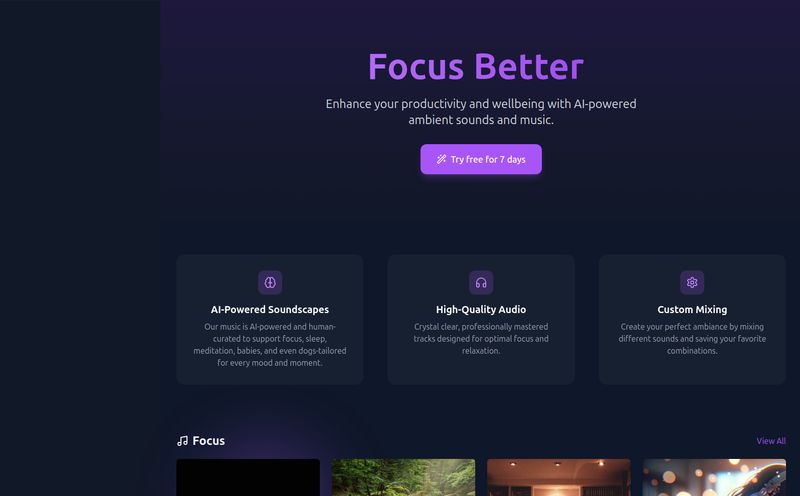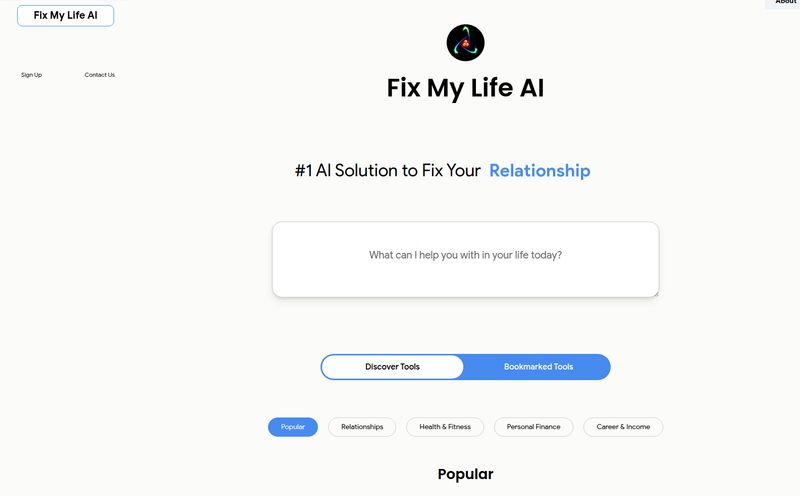The world of digital wellness can feel… crowded. There’s an app for meditating, an app for sleeping, an app for tracking your water intake until you’re practically swimming. I’ve been in the SEO and digital marketing game for years, and if there's one thing I know, it's the feeling of being perpetually “on.” My nervous system often feels like a browser with 57 tabs open, all playing different YouTube videos at once.
So when I first heard the term “nervous system fitness,” I was intrigued. But also, admittedly, a little skeptical. Is this just another buzzword? Another thing to add to the never-ending self-improvement checklist?
Then I stumbled upon Neurofit. It’s an app that promises to help you regulate your nervous system with simple, quick exercises. They claim active members report an average of 54% less stress after just one week. That’s a bold claim. One I had to check out for myself.
What Exactly Is This Neurofit Thing Anyway?
Okay, so Neurofit isn’t your typical meditation app. It’s not about just sitting still and “clearing your mind”—which, for me, is often an invitation for my anxiety to throw a rave. Instead, Neurofit is built on the principles of somatic exercises and nervous system regulation.
Think of your nervous system like the operating system on your computer. When it’s running smoothly, everything is fast and efficient. But when it gets overloaded with stress, anxiety, and burnout—the equivalent of digital junk files—it starts to lag. You get stuck in fight-or-flight mode (sympathetic state) or that heavy, shut-down, can’t-get-off-the-couch feeling (dorsal vagal state). Neurofit is designed to be the defragmenter tool that helps bring that system back into balance, into a state of calm and connection (ventral vagal state).
It does this through short, guided exercises that use your own body to send safety signals to your brain. It's less about thinking your way out of stress and more about moving and sensing your way to a calmer state.

Visit NEUROFIT App
My First Impressions and Getting Started
Signing up was straightforward. The app immediately asks you a few questions to generate a “Personalized Balance Score.” This score is meant to give you a baseline of where your nervous system is at—are you more wired and anxious, or more shut-down and fatigued? It's a neat little feature that gamifies the process a bit, which I appreciate.
The interface is clean and not overwhelming. It guides you to daily exercises based on your score and how you’re feeling. The best part? Most of these exercises are five minutes or less. This was a huge win for me. I don’t have time for a 45-minute yoga class in the middle of a Tuesday, but I can definitely spare three minutes to stop my brain from spinning out.
The Core Features That Actually Matter
While the app has a few different tools, a couple of things really stood out to me as being the most impactful.
Quick Somatic Exercises That Don't Feel Like a Chore
This is the heart of Neurofit. The exercises are simple and science-backed. One exercise might involve simply orienting yourself in your space by slowly looking around the room and naming objects. It sounds ridiculously simple, I know. But doing it pulls you out of your head and into the present moment, signaling to your brain that you're safe. Another might involve gentle tapping or self-massage. It’s all very grounded and physical, which is a refreshing change from purely mental exercises.
The Personalized Balance Score and Progress Tracking
I was initially wary that the Balance Score might be a gimmick, but I found it genuinely helpful. It gave me a tangible way to see how I was progressing. After a few days of consistent practice, seeing that score shift towards “Balanced” was surprisingly motivating. It turned an abstract feeling of “I think I feel a bit better?” into concrete data. For a data-driven person, this was a big plus.
Educational Content That Empowers You
Neurofit also includes short, easy-to-digest lessons about how the nervous system works. Understanding the why behind the exercises made them feel less like random tasks and more like a powerful tool I was learning to use. Knowing why looking around the room calms me down makes me more likely to do it when I’m feeling overwhelmed, even without the app.
So, Does Neurofit Actually Work? The Big Question
Here’s the thing. Did my stress magically vanish by 54% in one week? I didn’t run the numbers, but I can say this: I felt a noticeable difference. The constant, low-level hum of anxiety in my chest quieted down. When a stressful email landed in my inbox, my immediate reaction wasn't a full-body jolt. I felt more… grounded. Resourced. Like I had a bit more space between a trigger and my reaction.
However, and this is a big “however,” you have to be consistent. This isn't a magic pill. You can’t just do one exercise and expect a permanent change. It's called “nervous system fitness” for a reason—it’s a practice, like going to the gym. The benefits build over time. The app is a great guide, but you have to show up for those 3-5 minutes a day.
The Good, The Bad, and The Price Tag
No review is complete without a no-nonsense breakdown. So let's get into it.
The Good Stuff
Its a research-based platform, and you can feel it. The exercises are simple, effective, and incredibly quick. For anyone with a busy schedule, this is a massive advantage. The positive user reviews online seem to back this up—a lot of people are finding real relief with this tool.
Things to Keep in Mind
As I mentioned, consistency is everything. If you’re the type to download an app and forget about it a day later, this might not be for you. Also, and this is important, the app itself states its not a substitute for professional medical advice or therapy, especially for severe conditions. It's a wellness tool, not a clinical treatment.
Let's Talk About Neurofit Pricing
Okay, the money part. After a free trial, you’ll need a membership. Here’s how it breaks down:
| Plan | Cost | Details |
|---|---|---|
| 3-Month Membership | $39.99 USD | Access to all app features for 3 months. Works out to about $13.33/month. |
| Yearly Membership | $124.99 USD | Access to all app features for a full year. This comes down to roughly $10.41/month. |
Is it worth it? Honestly, compared to the cost of a single therapy session or even other premium wellness subscriptions, the price feels reasonable. If you think about it as an investment in your mental clarity and stress reduction, paying around $10 a month for the annual plan is a pretty good deal.
Who Is Neurofit For (And Who Should Maybe Skip It)?
I think Neurofit is a fantastic tool for a few specific types of people:
- The Chronically Stressed Professional: If your job keeps you in a state of high alert (hello, fellow marketers and freelancers), this is for you.
- The Burnt-Out Parent or Caregiver: When you have very little time for yourself, a 3-minute reset can be a lifesaver.
- Anyone Curious About Somatics: If you've heard about the mind-body connection but don't know where to start, Neurofit is an incredibly accessible entry point.
Who might want to look elsewhere? If you're looking for a one-and-done solution or a replacement for therapy for serious trauma or mental health conditions, this isn't it. It's a supportive tool, not a standalone cure.
The Final Verdict: A Worthy Investment for Your Inner Peace?
After spending some quality time with the Neurofit app, my initial skepticism has faded. It’s not just another wellness app floating in the digital ether. It's a practical, well-designed tool that delivers on its promise—if you’re willing to put in the (very minimal) work.
It has successfully carved out a unique space for itself by focusing on the body's role in stress. It's managed to make concepts like nervous system regulation and somatic exercises feel simple and achievable for the average person. For me, it’s earned a permanent spot on my phone's home screen. In a world that’s constantly demanding more from our nervous systems, having a tool like this in your back pocket feels less like a luxury and more like a necessity.
Frequently Asked Questions
- 1. How long does it take to see results with Neurofit?
- Neurofit claims users feel a significant reduction in stress within the first week. In my experience, I felt a noticeable shift in my reactivity and general calmness within a few days of consistent, daily use.
- 2. Are the exercises in Neurofit difficult?
- Not at all. The exercises are incredibly simple and designed to be done by anyone, anywhere. They typically involve gentle movements, breathing, or sensory awareness practices that take 5 minutes or less.
- 3. Can Neurofit replace therapy?
- No. Neurofit is a powerful wellness tool for managing daily stress and improving well-being, but it is not a substitute for professional mental health treatment or therapy, especially for severe conditions like PTSD or clinical anxiety.
- 4. What are somatic exercises?
- Somatic exercises are movements and practices focused on the internal experience of the body (the mind-body connection). The goal is to release physical tension and re-pattern the nervous system's response to stress by using the body as a way to communicate safety to the brain.
- 5. Is there a free trial for Neurofit?
- Yes, Neurofit typically offers a free trial period that allows you to explore the app and its features before committing to a paid membership.
- 6. What's the difference between Neurofit and a meditation app?
- While both aim to reduce stress, meditation apps often focus on mindfulness and observing thoughts. Neurofit focuses on somatic (body-based) exercises to directly interact with and regulate the nervous system's physiological state, making it more about physical regulation than mental observation.



